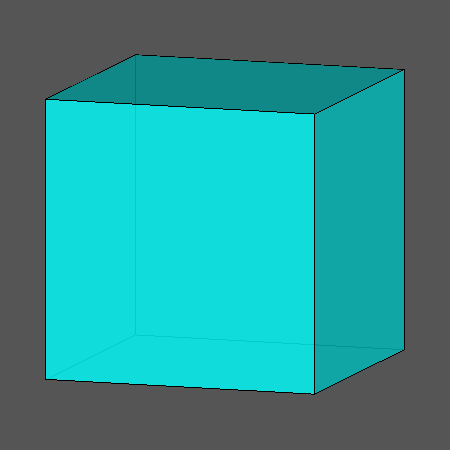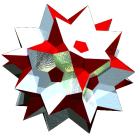|
Acronym
|
chic
|
|
Name
|
chamfered cube,
octahedrally truncated rhombic dodecahedron
|
|
|
 © ©  © ©
|
|
Vertex figure
|
[4,H2], [h3]
|
|
Coordinates
|
-
(1/2 + 1/sqrt(3), 1/2 + 1/sqrt(3), 1/2 + 1/sqrt(3)) & all changes of sign
(vertex inscribed cube)
-
(1/2, 1/2, 1/2 + 2/sqrt(3)) & all permutations, all changes of sign
|
|
General of army
|
(is itself convex)
|
|
Colonel of regiment
|
(is itself locally convex)
|
Dihedral angles
(at margins)
|
- between {4} and {(h,H,H)2}: 135°
- between {(h,H,H)2} and {(h,H,H)2}: 120°
|
|
Face vector
|
32, 48, 18
|
|
Confer
|
rad
cube
oq3oo4ux&zc
|
External
links
|



|
The non-regular hexagons {(h,H,H)2} have vertex angles h = arccos(-1/3) = 109.471221° resp. H = arccos[-1/sqrt(3)] = 125.264390°.
Octahedral truncation applies to the octahedral vertices (vertex inscribed oct) only. Wrt. the rad this
produces new square faces there. These are then face planes of a cutting cube. –
The above transition shows a dynamical mutual scaling of cube and rad.
The chamfered cube then is the instance, where all edges happen to have the same length.
However there also occurs a not so deep truncation as the Waterman polyhedron number 5 wrt. body-centered cubic lattice C3* centered at a lattice point (oq3oo4ux&#zc).
(Note that here the diagonals of the non-regular hexagons will not be side-parallel, while there they happen to be.)
Chamfering (or edge-only beveling – here is being applied to the cube) flatens the former edges into new
(non-regular hexagonal) faces.
There is a deeper, terminal chamfering of the cube too, which then reduces the original faces to nothing.
Then the hexagons will become rhombs and the total figure becomes the rad.
–
When considering the below provided tegum sum
Dynkin symbol, it becomes obvious that this figure also can be seen as a
Stott expansion of the rad.
Incidence matrix according to Dynkin symbol
ax4oo3oc&#zx → height = 0
a = (3+2 sqrt(3))/3 = 2.154701
c = sqrt(8/3) = 1.632993
(tegum sum of a-cube and (x,c)-sirco)
o.4o.3o. | 8 * | 3 0 | 3 0 [h3]
.o4.o3.o | * 24 | 1 2 | 2 1 [4,H2]
-------------+------+-------+-----
oo4oo3oo&#x | 1 1 | 24 * | 2 0
.x .. .. | 0 2 | * 24 | 1 1
-------------+------+-------+-----
ax .. oc&#zx | 2 4 | 4 2 | 12 * {(h,H,H)2}
.x4.o .. | 0 4 | 0 4 | * 6 {4}
©
©


